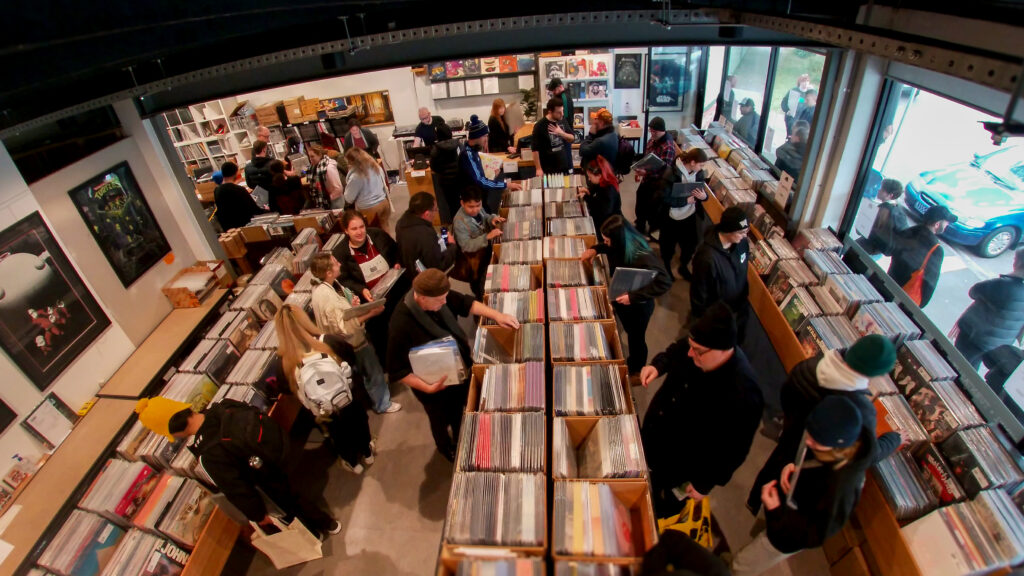“If anything it’s been a bit more intensive,” he says of the new album’s production method. “The biggest thing I learned from A Color Map was how I felt about telling the story of how it was made so much. That was important to me when the project started, and it continued to be important to me, but then towards the end and a little bit after the release I felt like it had become just as much about how it was done as what it was. So with this new project I’m doing an evolution on that whole production technique and style and implementing all the things I learned and just doing it better – with some differences – but I’m not trying to talk about it as much.”
The effort that goes into creating Pretty Lights’ music does make for a great story, but at the end of the day it’s the sounds produced that are of actual significance. “After A Color Map of the Sun I felt like I had invested a lot of energy into telling the story,” Smith says. “I don’t know if I would say that the work in the music was compromised at all, but I just wanted to make this project only about what the final product is – as opposed to making some point about production and sampling and timbre and whatever. Just let the music completely speak for itself without having any subsidiary assets and statements about what it is and why it is.”
Regardless of the magnified discussion about the recording process, A Color Map of the Sun did indeed speak for itself, gaining near-unanimous critical applause. This filled Smith with extra confidence when moving into his next project.
“I felt like I had discovered a new element to my style and that I wanted to evolve it and expand on it,” he says. “I felt like I was warming up. That record was finished and I was like, ‘All right cool – now I’m ready to make the record I want to make’, which is what I imagine that most artists say in a perpetual fashion. It’s like you’re constantly trying to catch up with your imagination – like you’re trying to catch up with being able to implement your ideas and then as soon as you can implement your ideas you’re trying to catch up to what you were imagining.”
Although his current process lets him competently articulate his stylistic vision, Smith hasn’t reached a point of creative contentment. “I’ve decided that when I finish this and put it out I want to switch back to shorter cycle projects, less expansive vision – or maybe just a different sort of cycle in how I approach it. I’m working on an album and more right now, but the ecosystem has changed so massively. I don’t think that ‘the album’ is necessarily where I want to be keeping my efforts all the time. There’s different cool ways to release music that’s not a full album – or just the traditional sense of an album, I should say.”
Smith has always been an album-oriented producer, and Pretty Lights’ four full-length releases have each been the realisation of a detailed concept. However, alternative release formats are becoming increasingly common, especially within the realm of electronic music.
“A lot of producers went to EPs – this whole idea of the EP or the short form album – and whole record labels and artists took the turn to just doing singles, one after another,” says Smith. “When I speak of shifting or changing my approach to releasing music, I’m still talking about a body of music. I think that the traditional album is just a technique and approach that artists who make albums have fallen into because that’s what listeners expect. Within some parameters – it’s over 35 minutes and it’s under 80 minutes and it’s at least this many songs. There’s a lot of parameters that can not exist, but I still am really keen on the whole body of work as opposed to one single after another. I just want to open everything up and do whatever I want to do when I want to do it.”
On the subject of abandoning standardising parameters, Smith’s forthcoming release – some of which will be debuted during his headline performance at the Rainbow Serpent festival later this month – has become much more than just an album. “I have an album I’m working on that’s a traditional thing and then also a lot of side assets, sort of in the way that I put out the raw recording sessions with A Color Map of the Sun as a B-disc. My idea on that was, ‘I’ll put out this record, and then I’m going to put out this second disc that opens people up to a certain part of what is to come.’ This project is expansive, but in that it’s got side assets and projects that are all musical, [which are] extensions of a traditional body of work. You can just hear all the different possibilities of the music.
“I came across this idea when I was making A Color Map of the Sun,” he continues.“I was like, ‘This music I’m making could exist in so many forms. I want to take it this way or want to take it this way; should I produce this track to be super hype for my live shows or make it exactly how I would want to listen to it?’ I really didn’t like even asking that question. In hindsight it’s obvious that I want to just make the music that I want to hear, but at the same time I am able to enjoy these other iterations or manifestations of these ideas. So I crafted this approach to producing and creating this record that would allow me to have multiple finished products that exist in different realms and just have a different idea of what a song is, or how a musical idea comes into existence.”
The more time one spends dedicated to a creative pursuit, the more that questions will arise regarding one’s ultimate aim and the meaning behind of all this tooling around. Smith inevitably encounters such questions, but they don’t intimidate him.
“I think I at some point agreed with some philosophy that there is no end goal. Rather, it’s just about the process of continually trying to create something that I think will stand the test of time or that I think is beautiful. I just try to embrace that. I create because I want to create and I want to create because I have ideas that haven’t been created and I think that they should be.
“I try to be in touch with my instincts and trust them all the time. Being in charge of the vision and where it’s going and how something is developing or coming into existence – it’s all about little decisions and big decisions that are made along the way. I trust my taste, my instinct and I don’t like to dilly-dally around trying decide if something should go left or right. I maintain a very strong direction and control over where it’s going just by trusting myself and always implementing that trust in the decisiveness throughout the process.”







